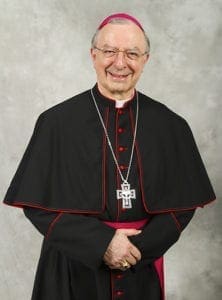The impact of inner-city Catholic school closures
By BISHOP JOEL M. KONZEN, S.M. | Published August 5, 2022 | En Español
For some years I have thought that there are a couple of doctoral dissertations or research projects I would like to see—one would be about the disproportionate number of engineering school graduates who are becoming priests and the other would be about the impact of the closures of inner-city Catholic schools in the last half century. I will dwell here on the second of these topics.

Bishop Joel M. Konzen, S.M.
In all of the dioceses where I have served—Atlanta, Austin, Washington, D.C., Cleveland, Lafayette in Louisiana, and New Orleans—I have seen the closure of some Catholic schools in the center of the city or near the center. I am aware of the same phenomenon having taken place in many other dioceses. In most cases, it was primarily the financial reality of spiraling subsidies and dwindling enrollments that led to the decision to close or merge the schools.
What happens any time a Catholic school is closed is some loss of enrolled students; they simply do not all transfer or begin at a different Catholic school. This is why it is important to maintain our schools, because closing them always entails some loss of those who would benefit from them.
In the case of these city schools, it is primarily students of color who have lost out as a result, such as when Our Lady of Lourdes and St. Anthony’s schools closed in Atlanta. These schools served a largely African American student population. Such was true also in Savannah, Birmingham and elsewhere. In Austin, it was the African American and Latino children who were displaced when their schools closed. Cleveland, Washington D.C. and New Orleans have done a better job than some dioceses of maintaining these inner-city schools. The question looms, though, of whether more might be shuttered in the future.
In 2020, Black students made up 7% of the total enrollment in U.S. Catholic schools, but they comprised 18% of the enrollment in schools that were permanently closed that year. That year, 147 Catholic schools closed, and 34 of those were composed of “minority-majority” student populations. This is the trend that I refer to, and it has been happening for a few decades. So, when we look around and see that our schools are short on Black and Hispanic students, it’s not only a matter of the schools’ cost and culture—although those are definitely factors. There is also the simple fact that the would-be feeder schools have often vanished. It must be said too that COVID has taken a bite out of some of these schools; their students did not or could not return in a timely fashion or needed to make other plans because of changing family situations brought on by the pandemic.
Of course, here in Atlanta, Cristo Rey Atlanta Jesuit High School, serving primarily Black and Latino students, is filled and has more applicants than it can take. It’s such a bright spot on the Catholic school landscape, but it’s the exception. We can only wonder how many more lives would have been positively impacted by the schools that no longer exist, and this is why it’s important for us all to support the schools we have but also to be planning as an archdiocese for how we will commit to serving the part of the population—especially our Catholic children—who live in areas where existing schools offer less-than-desirable outcomes and where Catholic schools would be the best avenue for strengthening the church’s outreach and for securing young people’s opportunities in the future.